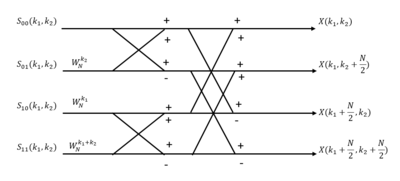Vector-radix FFT algorithm
The vector-radix FFT algorithm, is a multidimensional fast Fourier transform (FFT) algorithm, which is a generalization of the ordinary Cooley–Tukey FFT algorithm that divides the transform dimensions by arbitrary radices. It breaks a multidimensional (MD) discrete Fourier transform (DFT) down into successively smaller MD DFTs until, ultimately, only trivial MD DFTs need to be evaluated.[1]
The most common multidimensional FFT algorithm is row-column algorithm, which means transforming the array first in one index and then in the other, see more in FFT. Then a radix-2 direct 2-D FFT has been developed,[2] and it can eliminate 25% of the multiplies by the conventional row-column approach. And this algorithm has been extended to rectangular arrays and arbitrary radices,[3] which is the general Vector-Radix algorithm. Perhaps it is the simplest non-row-column FFT algorithm.
Vector-radix FFT algorithm can reduce the number of complex multiplications significantly, compared to row-vector algorithm. For example, for a time matrix (M dimensions, and size N on each dimension), the number of complex multiples of vector-radix FFT algorithm is , meanwhile, for row-column algorithm, it is . And generally, even larger savings in multiplies are obtained when this algorithm is operated on larger radices and on higher dimensional arrays.[3]
2-D DIT case
As with Cooley–Tukey FFT algorithm, two dimensional vector-radix FFT is derived by decomposing the regular 2-D DFT into sums of smaller DFT's multiplied by "twiddle" factor.
A decimation-in-time (DIT) algorithm means the decomposition is based on time domain , see more in Cooley–Tukey FFT algorithm.
We suppose the 2-D DFT
where ,and , and is a matrix, and .
For simplicity, let us assume that , and radix-( are integers).
Using the change of variables:
- , where
- , where
where or .
Then, the two dimensional DFT can be written as:

The equation above defines the basic structure of the 2-D DIT radix- "butterfly". (See 1-D "butterfly" in Cooley–Tukey FFT algorithm)
When , the equation can be broken into four summations: one over those samples of x for which both and are even, one for which is even and is odd, one of which is odd and is even, and one for which both and are odd,[1] and this leads to:
where
2-D DIF case
Similarly, a decimation-in-frequency (DIF, also called the Sande-Tukey algorithm) algorithm means the decomposition is based on frequency domain , see more in Cooley–Tukey FFT algorithm.
Using the change of variables:
- , where
- , where
where or .
And the DFT equation can be written as:
Other approaches
The Split-radix FFT algorithm has been proved to be a useful method for 1-D DFT. And this method has been applied to the vector-radix FFT to obtain a split vector-radix FFT.[4][5]
In conventional 2-D vector-radix algorithm, we decompose the incident into 4 groups:
By the split vector-radix algorithm, the first three groups remain unchanged, the fourth odd-odd group is further decomposed into another four sub-groups, and seven groups in total:
That means the fourth term in 2-D DIT radix- equation, becomes:
where
The 2-D N by N DFT is then obtained by successive use of the above decomposition, up to the last stage.
It has been shown that the split vector radix algorithm has saved about 30% of the complex multiplications and about the same number of the complex additions for typical array, compared with the vector-radix algorithm.[4]
References
- 1 2 Dudgeon, Dan; Russell, Mersereau (September 1983). Multidimensional Digital Signal Processing. Prentice Hall. p. 76. ISBN 0136049591.
- ↑ Rivard, G. "Direct fast Fourier transform of bivariate functions". IEEE Transactions on Acoustics, Speech, and Signal Processing. 25: 250–252. doi:10.1109/TASSP.1977.1162951.
- 1 2 Harris, D.; McClellan, J.; Chan, D.; Schuessler, H. "Vector radix fast Fourier transform". Acoustics, Speech, and Signal Processing, IEEE International Conference on ICASSP '77. 2: 548–551. doi:10.1109/ICASSP.1977.1170349.
- 1 2 Pei, Soo-Chang; Wu, Ja-Lin (April 1987). "Split vector radix 2D fast Fourier transform". Acoustics, Speech, and Signal Processing, IEEE International Conference on ICASSP '87.: 1987–1990. doi:10.1109/ICASSP.1987.1169345.
- ↑ Chan, S. C.; Ho, K. L. "Split vector-radix fast Fourier transform". IEEE Transactions on Signal Processing. 40: 2029–2039. doi:10.1109/78.150004.